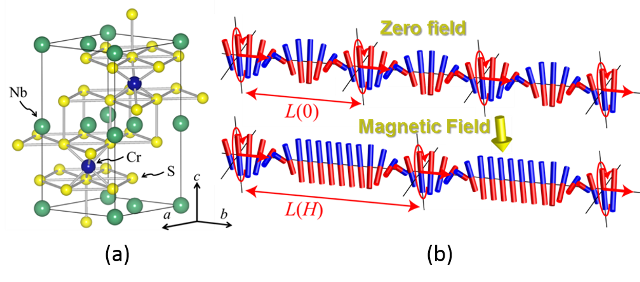Feb 11 2016
 (a) Crystal structure of a chiral crystal of CrNb3S6. (b) Magnetic twists formed in a chiral crystal, schematically illustrated by an array of bar magnets arranged in the form of a spiral. [Credit: Yoshihiko Togawa, Osaka Prefecture University]
(a) Crystal structure of a chiral crystal of CrNb3S6. (b) Magnetic twists formed in a chiral crystal, schematically illustrated by an array of bar magnets arranged in the form of a spiral. [Credit: Yoshihiko Togawa, Osaka Prefecture University]
Members from a research collaboration called “A Consortium to Exploit Spin Chirality in Advanced Materials” has succeeded in experimentally establishing the properties of crystals of chiral magnetic materials. This could lead to the development of new varieties of magnetic memories with remarkable storage capacities. In 2015, the collaboration was established by scientists from a number of countries, including the UK, Russia, and Japan.
It is a great success for our international consortium, as we achieved the result effectively by taking advantage of the organization that is composed of experts in various research fields.
Katsuya Inoue, Professor, Hiroshima University’s Graduate School of Science
Magnetic materials containing chiral crystalline structures are called chiral magnets, CrNb3S6 is an example. These materials exhibit a novel magnetic twisting effect under the influence of a weak external magnetic field. The material appears as if it contains helically arranged atomic-scale magnets.
In December 2015, researchers demonstrated that by changing the strength of the external magnetic field, the number of twists can be electrically observed and controlled. The researchers created a small device, which was the size of a human cell, from CrNb3S6. They found that a series of discrete values were taken by the electrical resistance,which changes in a stepwise manner upon alterations in the strength of the external magnetic field.
The researchers then used electron microscopy to demonstrate that the electrical resistance changes in correspondence with the variation of the twisting of the magnetic field. With the help of this device, the researchers presented data of 20 distinct states, and successfully detected these states in an unambiguous manner.
Standard electronic devices, utilized as components in current electronic appliances, control information such as binary data, represented by the combination of “0” and “1”. The magnetic field’s orientations, namely “up” and “down,” represent the two states of the magnetic materials.
The new devices, developed from chiral magnets, perform data handling as a combination of multiple digits in correspondence with the number of twists created in the chiral magnets.
For example, the capacity of a storage memory device composed of 10 such new element devices made from chiral magnets, each of which has 10 discrete states, will be 1010, which is about 10 million times larger than that of a conventional magnetic storage memory with the same number of conventional element devices.
Dr. Yoshihiko Togawa, Osaka Prefecture University
Current studies are dealing with the technological and scientific aspects of these results to realize future practical applications, like multiple-valued magnetic memories, logic devices, or sensors with high storage capacities, thanks to the material’s novel characteristic features.